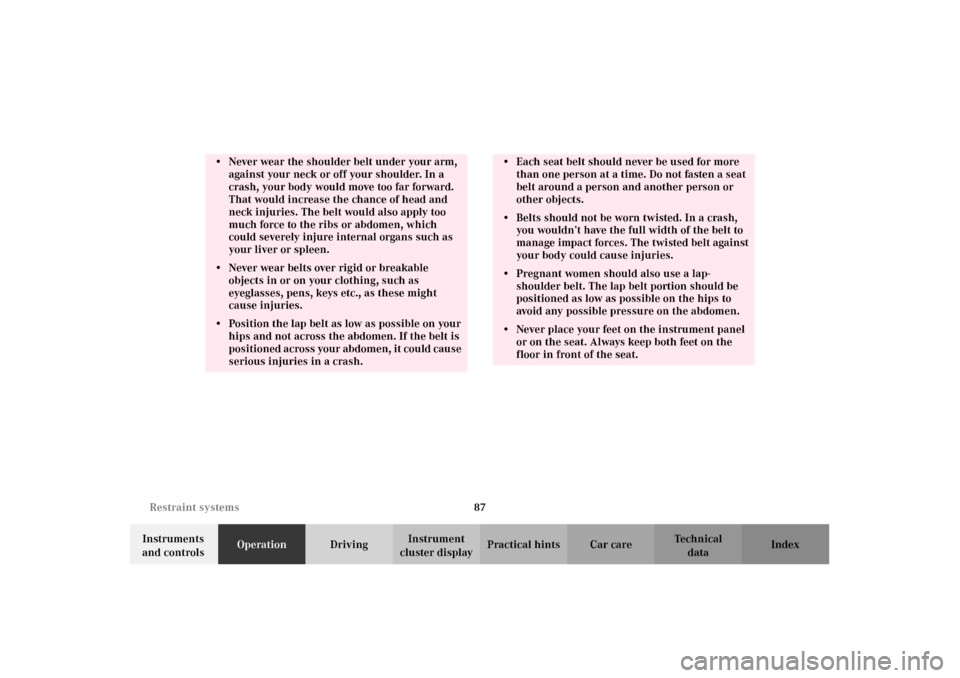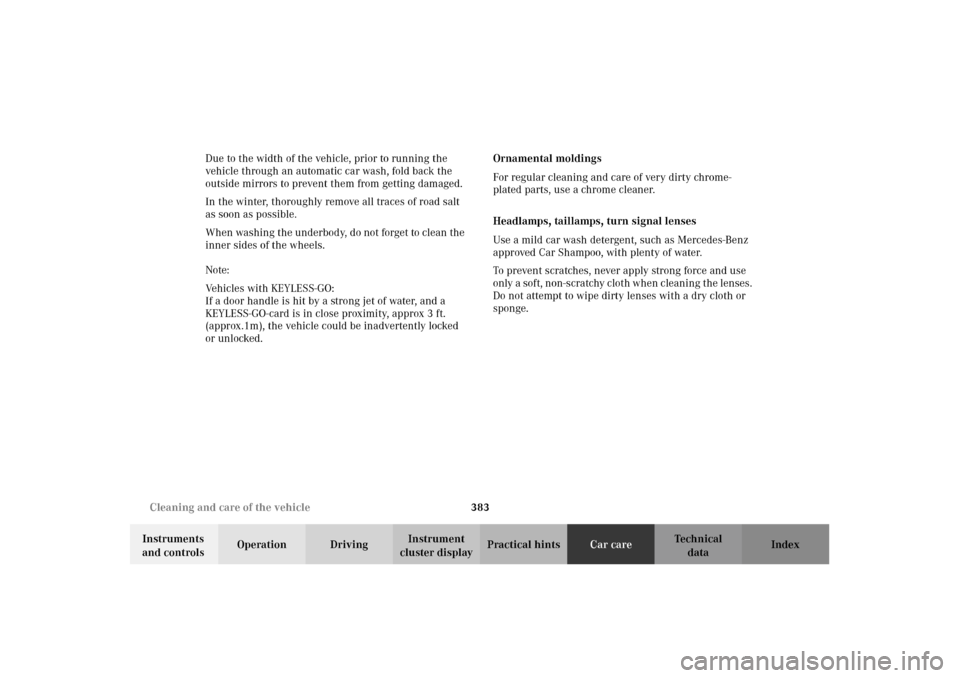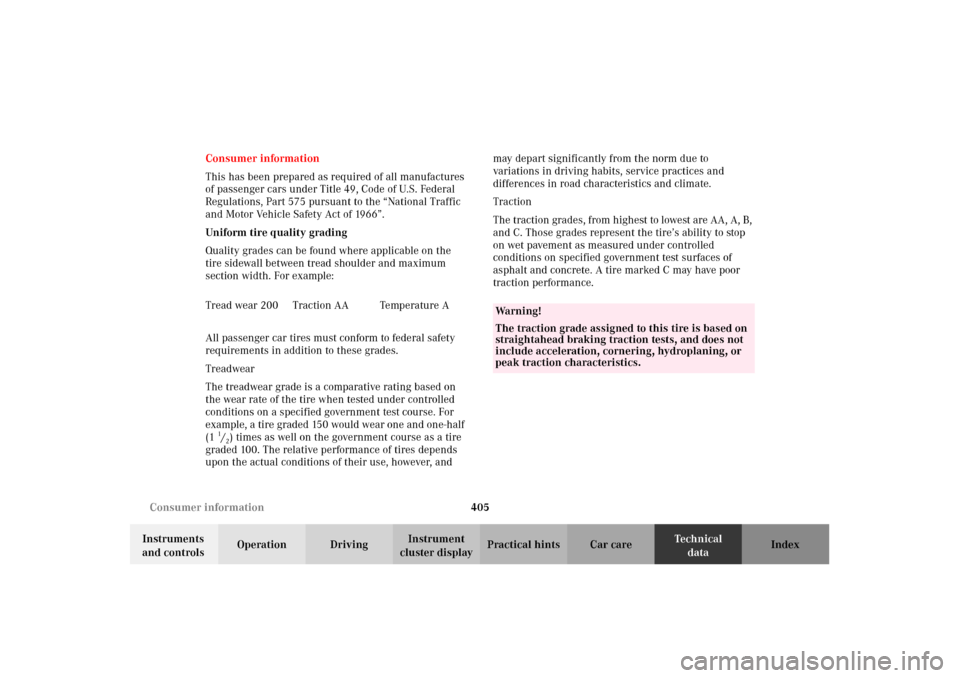Page 90 of 430

87 Restraint systems
Te ch n i c a l
data Instruments
and controlsOperationDrivingInstrument
cluster displayPractical hints Car care Index
• Never wear the shoulder belt under your arm,
against your neck or off your shoulder. In a
crash, your body would move too far forward.
That would increase the chance of head and
neck injuries. The belt would also apply too
much force to the ribs or abdomen, which
could severely injure internal organs such as
your liver or spleen.• Never wear belts over rigid or breakable
objects in or on your clothing, such as
eyeglasses, pens, keys etc., as these might
cause injuries.• Position the lap belt as low as possible on your
hips and not across the abdomen. If the belt is
positioned across your abdomen, it could cause
serious injuries in a crash.
• Each seat belt should never be used for more
than one person at a time. Do not fasten a seat
belt around a person and another person or
other objects.• Belts should not be worn twisted. In a crash,
you wouldn’t have the full width of the belt to
manage impact forces. The twisted belt against
your body could cause injuries.• Pregnant women should also use a lap-
shoulder belt. The lap belt portion should be
positioned as low as possible on the hips to
avoid any possible pressure on the abdomen.• Never place your feet on the instrument panel
or on the seat. Always keep both feet on the
floor in front of the seat.
J_OM_215.book Seite 87 Mittwoch, 30. Mai 2001 2:01 14
Page 386 of 430

383 Cleaning and care of the vehicle
Te ch n i c a l
data Instruments
and controlsOperation DrivingInstrument
cluster displayPractical hintsCar careIndex Due to the width of the vehicle, prior to running the
vehicle through an automatic car wash, fold back the
outside mirrors to prevent them from getting damaged.
In the winter, thoroughly remove all traces of road salt
as soon as possible.
When washing the underbody, do not forget to clean the
inner sides of the wheels.
Note:
Ve h i c l e s w i t h KE Y L E S S - G O :
If a door handle is hit by a strong jet of water, and a
KEYLESS-GO-card is in close proximity, approx 3 ft.
(approx.1m), the vehicle could be inadvertently locked
or unlocked.Ornamental moldings
For regular cleaning and care of very dirty chrome-
plated parts, use a chrome cleaner.
Headlamps, taillamps, turn signal lenses
Use a mild car wash detergent, such as Mercedes-Benz
approved Car Shampoo, with plenty of water.
To prevent scratches, never apply strong force and use
only a soft, non-scratchy cloth when cleaning the lenses.
Do not attempt to wipe dirty lenses with a dry cloth or
sponge.
J_OM_215.book Seite 383 Mittwoch, 30. Mai 2001 2:01 14
Page 401 of 430
398 Technical data
Te ch n i c a l
data Instruments
and controlsOperation DrivingInstrument
cluster displayPractical hints Car care Index
Main Dimensions
We i g h t s Model CL 500 CL 55 AMG CL 600
Overall vehicle length 196.4 in (4989 mm) 196.4 in (4989 mm) 196.4 in (4989 mm)
Overall vehicle width 73.1 in (1857 mm) 73.1 in (1857 mm) 73.1 in (1857 mm)
Overall vehicle height 55.4 in (1408 mm) 55.4 in (1408 mm) 55.4 in (1408 mm)
Wheel base 113.6 in (2885 mm) 113.6 in (2885 mm) 113.6 in (2885 mm)
Track, front 62.1 in (1577 mm) 62.2 in (1581 mm) 62.1 in (1577 mm)
Track, rear 62.1 in (1578 mm) 62.1 in (1578 mm) 62.1 in (1578 mm)
Roof load max. 220 lb (100 kg)
Trunk load max. 220 lb (100 kg)
J_OM_215.book Seite 398 Mittwoch, 30. Mai 2001 2:01 14
Page 408 of 430

405 Consumer information
Te ch n i c a l
data Instruments
and controlsOperation DrivingInstrument
cluster displayPractical hints Car care Index Consumer information
This has been prepared as required of all manufactures
of passenger cars under Title 49, Code of U.S. Federal
Regulations, Part 575 pursuant to the “National Traffic
and Motor Vehicle Safety Act of 1966”.
Uniform tire quality grading
Quality grades can be found where applicable on the
tire sidewall between tread shoulder and maximum
section width. For example:
All passenger car tires must conform to federal safety
requirements in addition to these grades.
Treadwear
The treadwear grade is a comparative rating based on
the wear rate of the tire when tested under controlled
conditions on a specified government test course. For
example, a tire graded 150 would wear one and one-half
(1
1/2) times as well on the government course as a tire
graded 100. The relative performance of tires depends
upon the actual conditions of their use, however, and may depart significantly from the norm due to
variations in driving habits, service practices and
differences in road characteristics and climate.
Traction
The traction grades, from highest to lowest are AA, A, B,
and C. Those grades represent the tire’s ability to stop
on wet pavement as measured under controlled
conditions on specified government test surfaces of
asphalt and concrete. A tire marked C may have poor
traction performance.
Tread wear 200 Traction AA Temperature A
Wa r n i n g !
The traction grade assigned to this tire is based on
straightahead braking traction tests, and does not
include acceleration, cornering, hydroplaning, or
peak traction characteristics.
J_OM_215.book Seite 405 Mittwoch, 30. Mai 2001 2:01 14